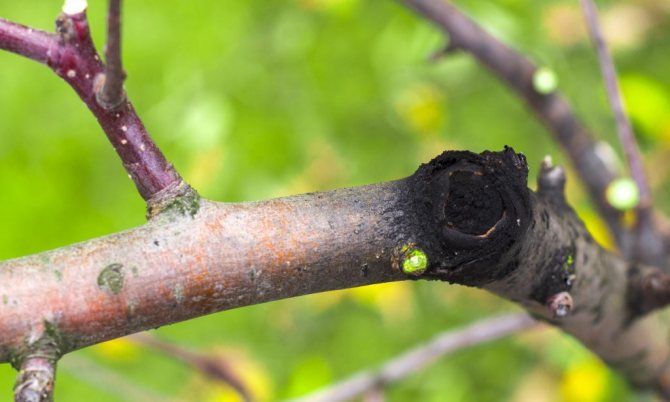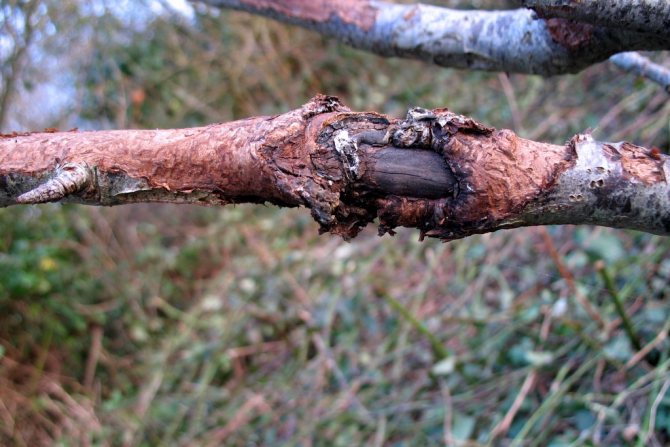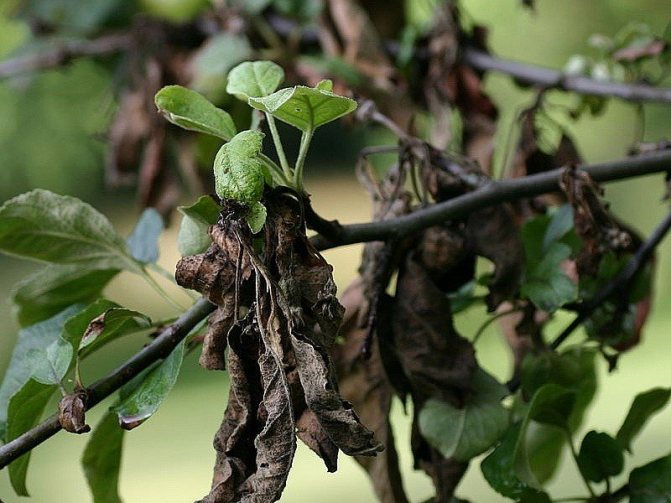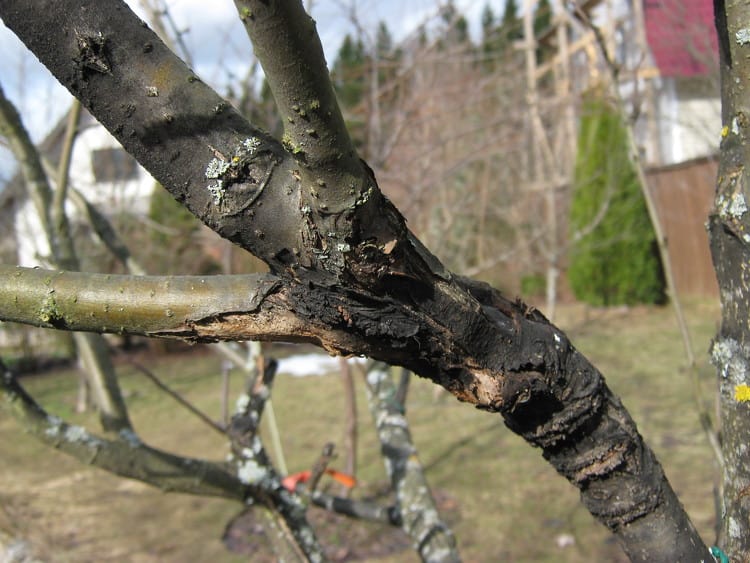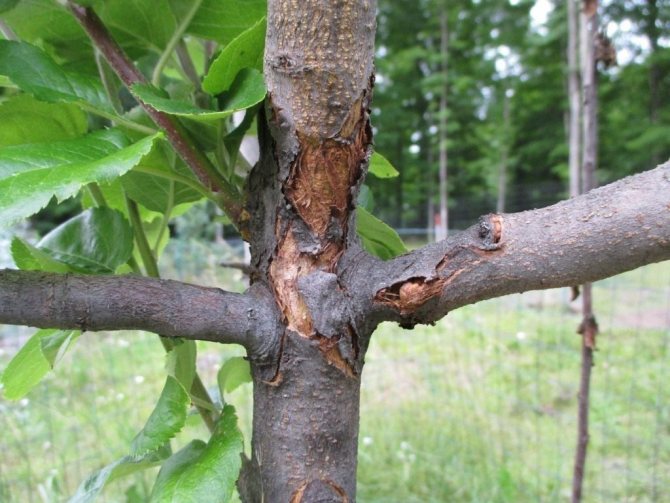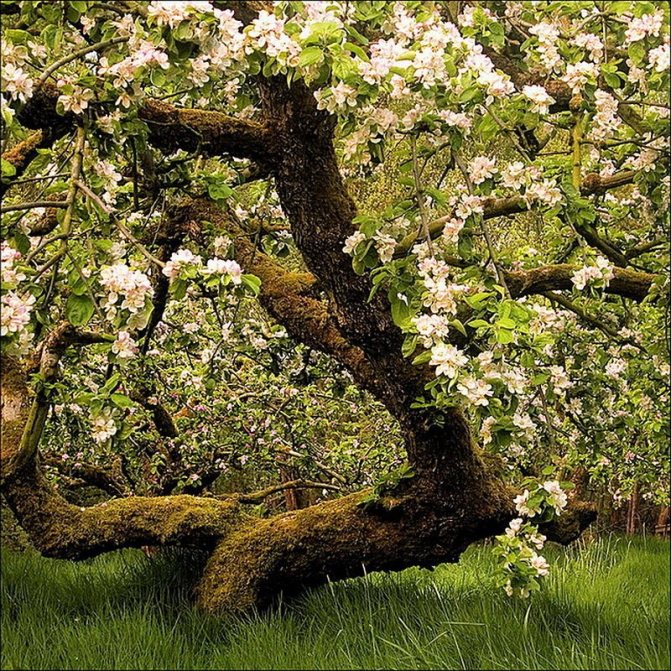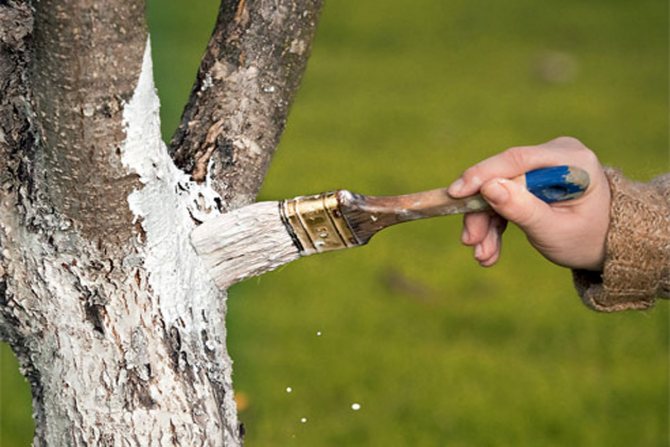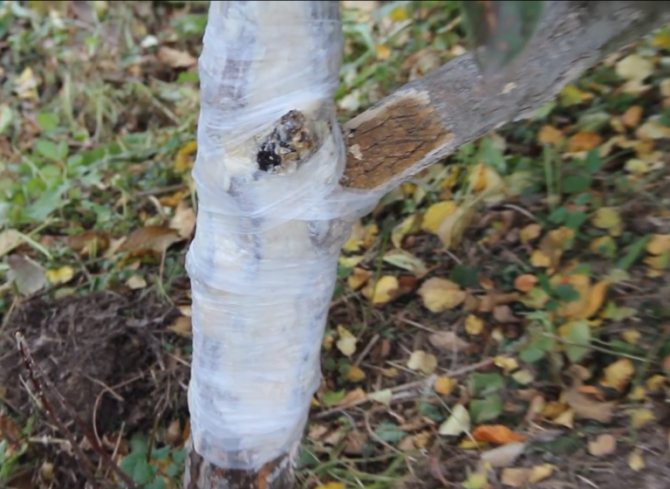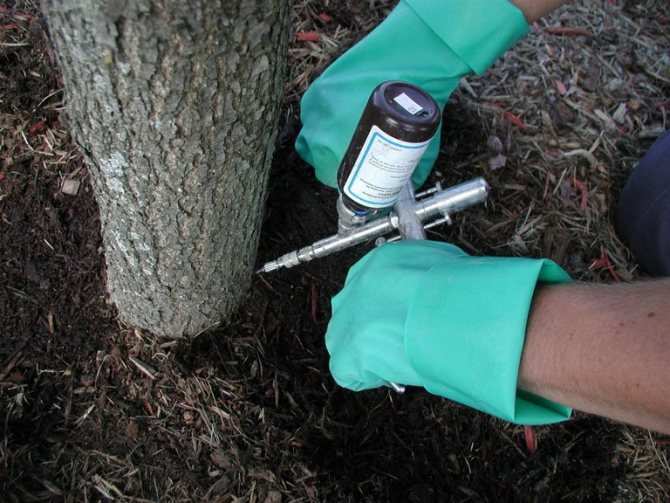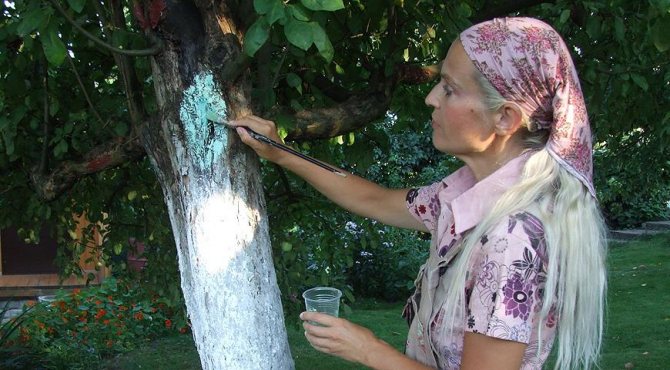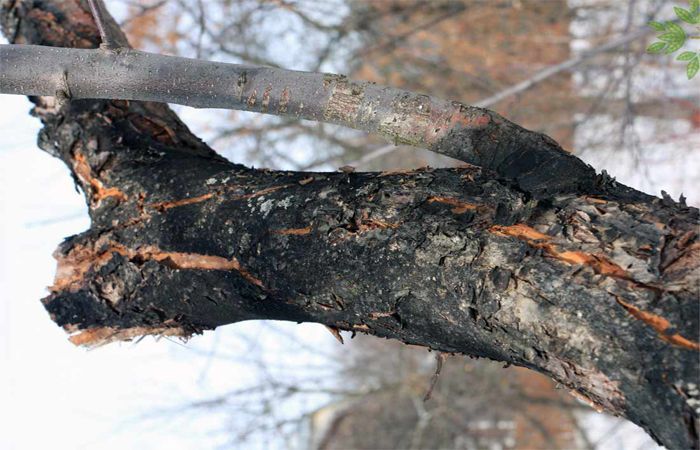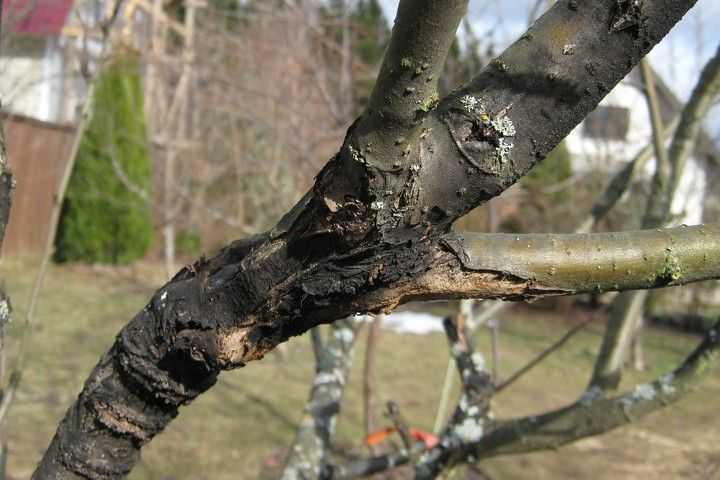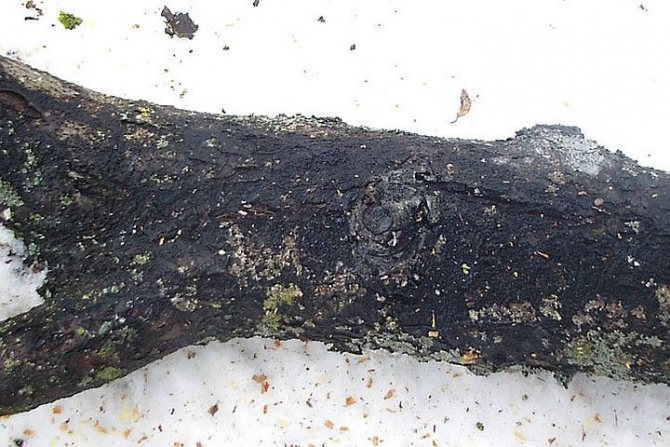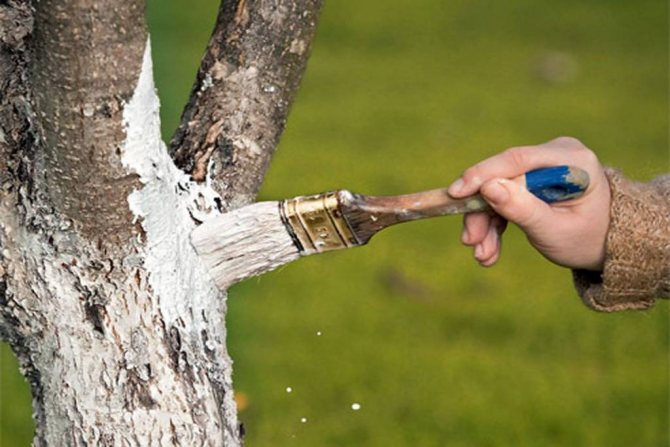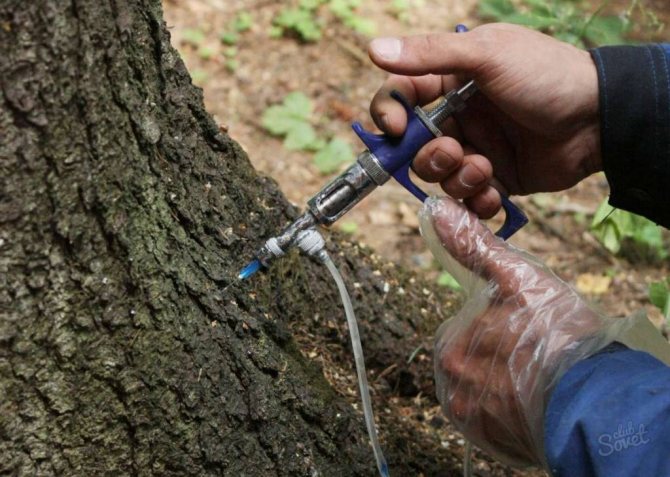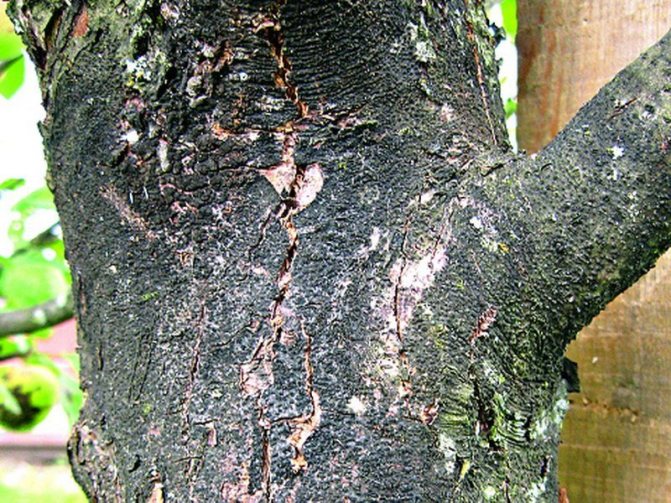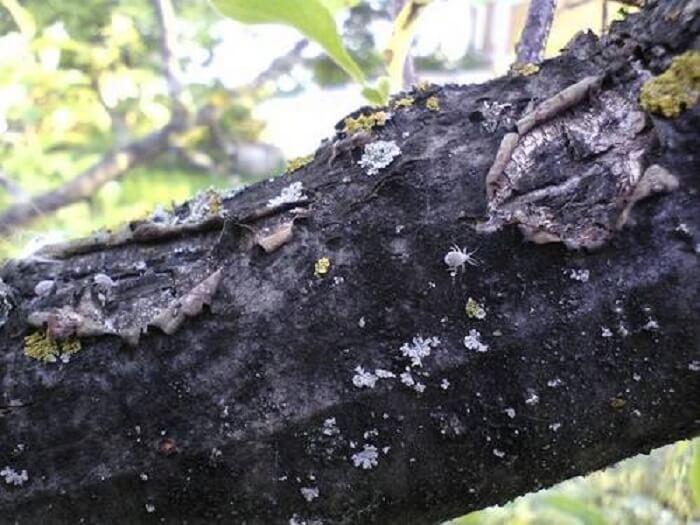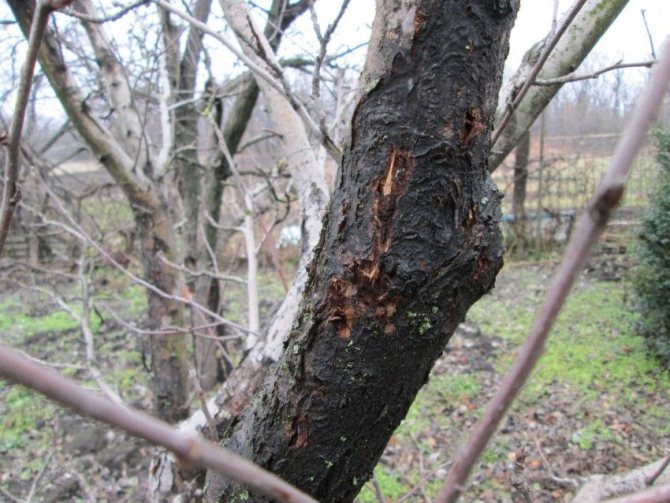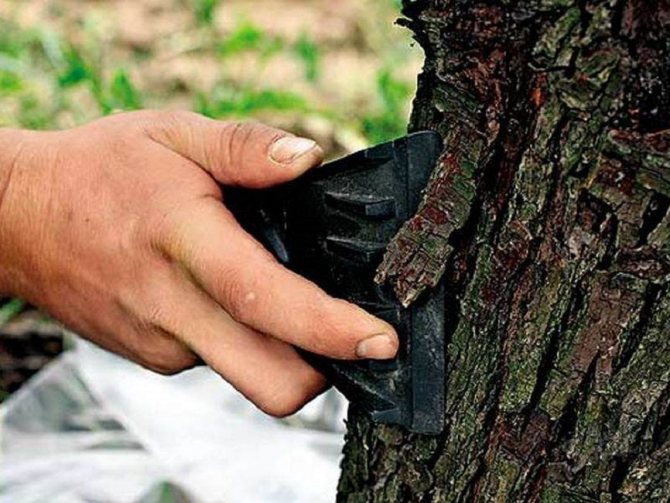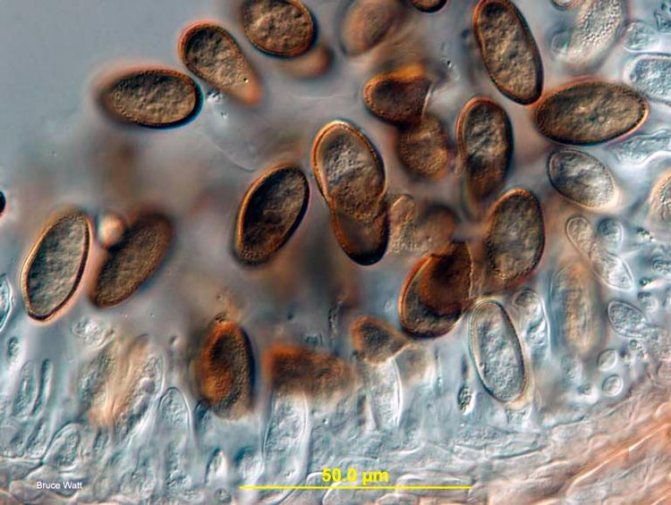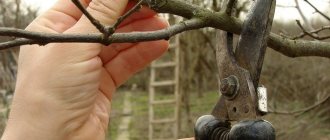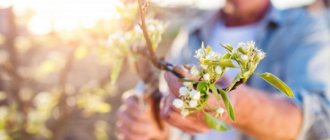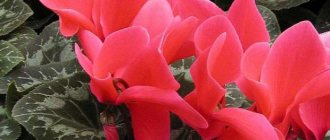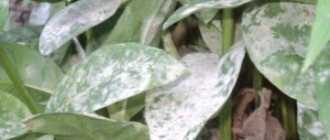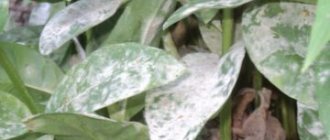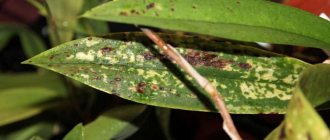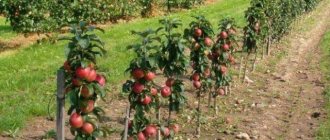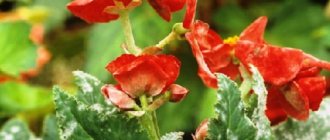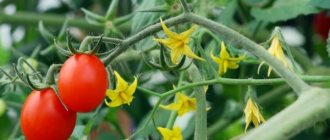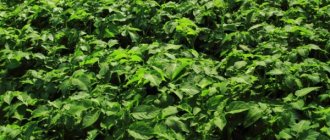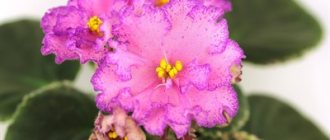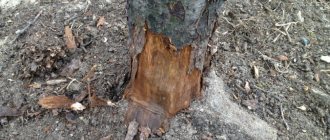In our beautiful gardens, the most respected tree is, of course, the apple tree. No fruit can compare with an apple in terms of its therapeutic effect on the human body. The productivity of this tree is amazing. Several hundred kilograms of fragrant apples from one tree are stored in basements until new harvests.
Unfortunately, the widespread distribution of the apple tree has led to the massive development of its pests, as well as the expansion of fungal and viral diseases. One of these, the most dangerous, is the black apple cancer.
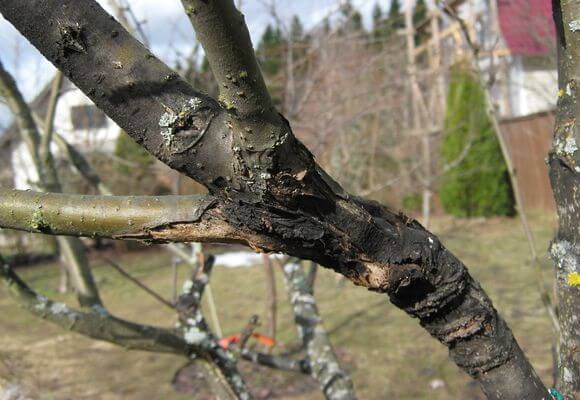
Studying the enemy
Black apple cancer is a rapid diseasewhich leads to the death of the tree. Such a bacterial cancer of the apple tree has been known for a long time.
The people compared it to gangrene: a disease that, in the Middle Ages, practically did not respond to treatment and killed many people. Monk Anthony was the only one who sometimes managed to save the sick from this scourge.
From here surviving to this day the name of the black cancer is "antoniev or antonov fire".
Also, the defeat of black cancer is known as "fireworm", because the apple tree in places where bacteria accumulate seems to be burned.
The causative agent of black cancer is a marsupial mushroom of the Botriosphere family - Sphaeropsis malorum Peck.
Mushrooms of this species are able to parasitize both on living tissue of plants and on already dead.
The infection can affect any aerial part of the apple tree.
The most dangerous is bark infectionwhere the fungus gets through the wounds. Treating black cancer in apple trees is the main task of the gardener.
Attention! Any damage to the bark is a potential site of infection. These include untreated cuts, sunburns, frostbites, and bird and animal wounds.
Output
Black apple cancer is a serious disease that requires immediate treatment. The effect of the treatment will depend on the stage of the apple tree disease. Currently, there are many ways and drugs to combat this ailment, but the best of them is the tree's own immunity. His protective forces, which are formed by adhering to agricultural techniques and simple rules for caring for an apple tree.
If it was not possible to save the garden, then it is advisable to remove all plantings along with the roots, burn them and wait a couple of years when the earth is cleared of spores and all pathogens. Then it will be possible to grow new young seedlings.
Optimal conditions for infection
Positive temperature
Most often infection occurs in early spring.
The fungus enters the active phase as soon as the air temperature becomes positive.
The most favorable conditions for development occur in summer, when the temperature reaches 22-28 degrees.
Disputes have time to fully mature in just 6 hours. Even at 40 degrees, the mushroom feels comfortable.
Poor quality trees
Good conditions weakened, old apple trees are created for the development of infectionthat are difficult to resist the parasite. Such trees are the first to become infected, the immunity does not allow them to actively fight the infection.
As a result, the mycelium of black crayfish multiplies rapidly, ripened spores are released at high air humidity and infect the surrounding trees.
Strong young apple trees are able to cope with the parasite on their own. Rapid tissue regeneration prevents cancer from entering the body of the tree.
Young trees will not completely protect against cancer, but will drastically reduce the chances of developing an infection.
Improper care or lack of care
Neglecting pruning rules, leaving open wounds, too thick tree crowns - all this contributes to the spread of the disease.
Trees affected by pests are at risk of infection and diseases of a fungal or bacterial nature such as scab, powdery mildew, etc.
Important! Mosses and lichens that develop on the trunks and in the crowns of trees create optimal conditions for the development of infection - they are warm and humid in their habitat.
Excessive grooming
With excessive nutrition mineral and organic substances accumulate in the soil in excess. A breeding ground is created for the development of fungal infection.
Incorrect fit
Apple trees planted too close stimulate the rate of infestation of the garden... In recent years, the intensive garden with compacted planting has become popular.
In order to avoid black cancer, apple trees planted in this way need constant examination and intensive care.
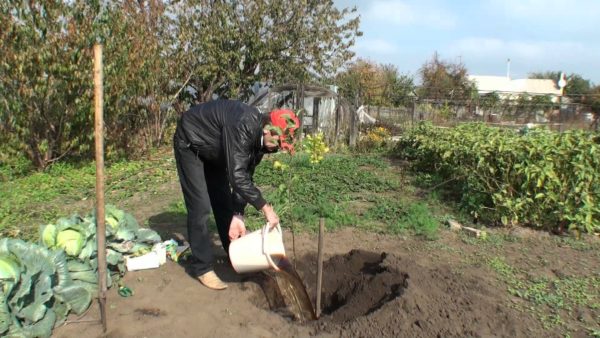

Planting an apple tree.
Planting apple trees deeply also puts them at risk of infection.
Important! Do not plant fruit trees near compost pits and toilets. To maintain the health of the garden from any place where organic matter is actively decomposing, when planting fruit trees, you should retreat at least 3 meters.
Symptoms of a bacterial infection
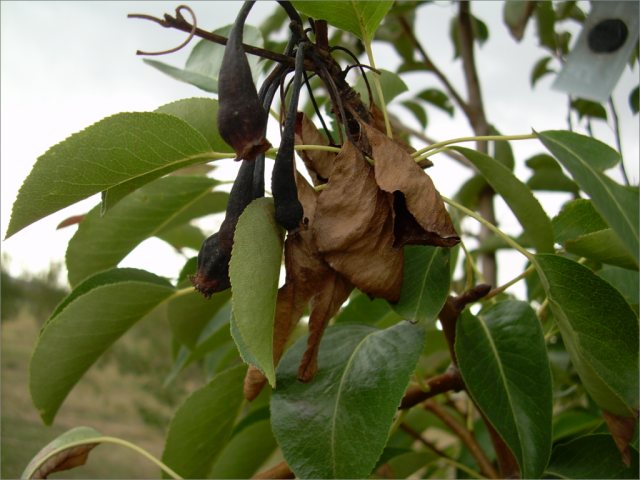

Bacterial burn of an apple tree. <>
Typical symptoms of bacterial damage to the aboveground organs of apple trees:
at bacterial cancer or bacterial necrosis are the appearance of blisters on young shoots, which open up, exposing the internal tissues of the plant. The leaves are covered with brown spots. In general, the affected plant organs have dents of pink-brown colors with a purple border,
at fire blight the affected tree branches look scorched by fire. The manifestation of the disease begins in early spring (budding) in the form of browning and blackening of the generative and vegetative organs, the cessation of their growth and development. The tree may suddenly die or become covered with bubbles of various sizes filled with bacterial mucus. It flows from wounds, ovaries, cracks in the bark, bursting bubbles. Covers the affected organs with a gray film or solidifies in the form of milky white drops. The multiplied bacteria move from young to larger plant organs through the vessels, causing the death of the entire plant,
at bacterial root cancer the disease can manifest itself first on the root collar and then on the trunk and branches of trees in the form of smooth growths, which ulcerate over time and acquire a brown or black color. Bacteria, penetrating into tissues through wounds, cracks, cuts (cuts), damage to the integrity of the bark by insects, develop rapidly. They cause increased division of tissue cells and, as a result, the growth and formation of slugs. The influxes decay over time, bacteria move into the healthy tissue of aboveground and underground organs, including the roots. Growing on the roots, the tumor becomes hard. The aboveground and underground organs cannot function normally and the tree dies.
How to recognize?
Black cancer in an apple tree is difficult to recognize at an early stage. In the spring, as soon as the snow melts, it follows carefully examine the apple orchardto detect signs and symptoms of black cancer.
Bark
While the buds are sleeping, it is necessary to examine the outer layer of the wood.
If it has wounds or cracks, it is worth examining them under a magnifying glass.
If the apple tree contracted black cancer, small dots will be visible around the wounds... They are located in circles.
If the disease is in an active stage, it can be seen with the naked eye. The trunk and skeletal branches are covered with deep black spots with a tint of purple or brown. They grow in diameter the bark is covered with black bloomas if the tree was burnt. The lesions crack, turn inside out, exposing wood, which also turns black over time.
In the last stage, the disease forms a ring around the entire branch.... If the last stage of black cancer is observed on the trunk or fork of the apple tree skeleton - how to save the apple tree from black cancer? The answer is no way. Impossible. It dries up and dies.
Flowers
Flaws appear on the petals of the inflorescences brown... The flower deforms, becomes black from the inside.
Fruit
Black cancer practically does not appear on ovaries and fruits until they reach medium size.
Active infestation of the fruit usually begins when the apples are already poured. On barely ripe fruits black putrid spots are formed.
One fruit - one point... It grows rapidly, becomes covered with spores, until it absorbs the entire surface of the apple.
The fruit becomes smooth, its color can be described as deep black... The color has no additional shades.
Leaves
On the leaves of the apple tree, the disease manifests itself in the form of spots affected by spores. The color of the lesion is dark brown or red., in the center, the spores form small dotted circles.
The size of the lesions grows, the circles turn into a solid bloom of gray. This causes the leaves to dry out and fall off.
The disease can provoke summer leaf fall, in which the tree loses almost all its foliage long before the cold weather.
Result:
- Poor fruiting
- Dangerous wintering.
In the absence of leaf mass, the apple tree cannot accumulate enough strength to survive the cold. The wood of young shoots does not have time to ripen. There is a risk that the tree will die from frostwithout waiting for cancer to destroy it.
Disguise
The most dangerous disease is black cancer, often disguised as other diseases of apple trees.
Its symptoms can be confused with cytosporosis and common cancer.
If we draw conclusions on the defeat of the fruits, then with moniliosis, in which the fruits also turn black, only acquire a blue tint.
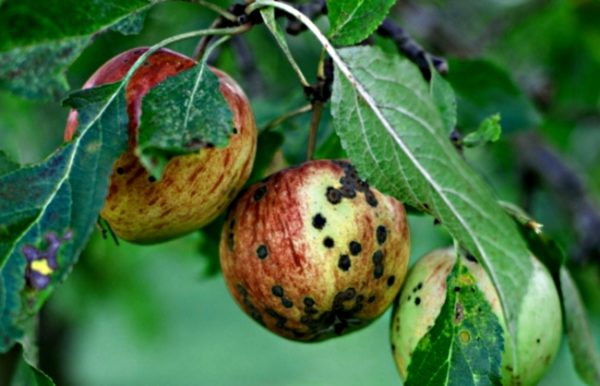

Diseases of the apple tree.
With none of these diseases, the apple tree does not acquire the effect of charred branches. Defeats from cancer convex, with circles of saturated color: red or brown.
When cytosporosis the wounds are round, but gray, and the bark is covered with bumps, looks torn, disheveled.
It happens that the bark on the tree is completely absent. If there is no bark on the apple tree Is not necessarily a black cancer.
Perhaps this is the result of the actions of a bark beetle or another pest that lives in cambium and wood. Pests can cause significant harm to the bark, up to the complete exposure of the trunk.
Attention! A weak tree can be susceptible to a whole range of diseases, so the combination of black cancer with other infections is not uncommon.
Bacterial cancer - symptoms
In the case of infection of cherries and sweet cherries, bacterial cancer leads to browning and drying of flowers in the spring.... Then, from the affected flowers, bacteria penetrate the branches, causing a jelly-like orange liquid to flow out. Over time, thickening and damage to the bark appear on the branches. On the leaves of infected trees, watery, yellow spots are visible, which eventually turn brown and roll up inside the leaf, small (2-3 mm) holes appear on the leaves. The fruits are covered with brown, putrid spots.
Bacterial cancer symptoms are also common on peach and apricot.... Slightly less often on apple or pear.In the last two species, flowers are extremely rarely affected, and on pear fruits, the spots that appear are black. On apples, however, such spots usually do not appear at all. Brown spots appear on the leaves of the pear, may be surrounded by a red border.
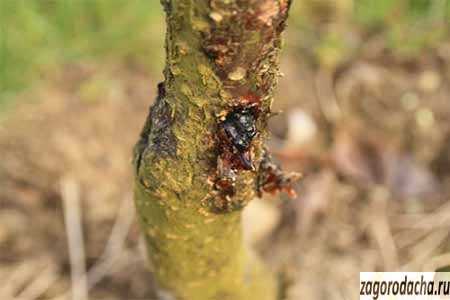

Is the disease dangerous for humans?
The word "cancer" in the name of the apple tree disease scares gardeners. So the question is, can this fungal infection being contagious to humans, occurs quite often.
Apple cancer is so named because by infecting a tree, the fungus affects the genetics of the plant, causes active cell division and tissue death.
The rest the nature of plant and human cancer is different... A person cannot get sick with plant cancer.
Eating apples from infected trees will not do any harm. If the fruit is clean, not rotten.
Advice. Rotten apples should not be eaten. They can cause poisoning in humans and animals.
Lichen diseases of apple trees: description with photos
Representatives of the genera Cladonia, Hypogymnia, Parmelia are widespread among lichens, and among mosses - Dicranum, Mnium, etc. Lichen diseases are found everywhere on all berry bushes and trees.
The description of these diseases of apple trees should start with the fact that they develop with thickened plantings, poor ventilation, low illumination of the bushes, conditions of high humidity are created. Such conditions are very favorable for the development of lichens and mosses, pathogenic microorganisms that cause bark necrosis, stem and root rot.
Lichen thallus retain moisture on the surface of the bark, which can cause the formation of frost cracks in severe winters, and many pests constantly overwinter under the thallus. The spread of lichens and mosses indicates, first of all, the weakening of plants.
Seeing the description of the apple tree disease with photographs, you can arm yourself with the knowledge of the potential danger and begin to fight it as recommended below.
Control measures. Constant cleaning and removal of thalli from trunks and skeletal branches and spraying plants in autumn with a solution of ferrous sulfate (300 g / 10 l of water).
How to cure an apple tree from black cancer?
Previously, it was believed that the treatment of apple cancer is useless, you can only slow down the spread of the disease and the death of the tree by 2-4 years is inevitable.
Modern tools allow destroy the colonies of the fungus and stop the disease.
The most important condition - to detect the disease at an early stage. At later stages, attempts are unlikely to be crowned with success. Treatment for black cancer should be comprehensive.
Cleaning
Before treating black cancer on an apple tree, you need to clean up: cut out unhealthy branches, remove diseased leaves and fruits.
Burn all affected parts of the apple tree. If there are trees in the garden that are heavily affected by black cancer, they must be removed at this stage.
Important! When removing apple trees from patients with black cancer, it is important to chop off the roots as deeply as possible.
Operations on the bark of the apple tree trunk and skeletal branches
Skeletal branches ringed with fungal infection must be deleted entirely, they will still dry up and die.
Local foci of infection on the bark and branches are destroyed mechanically, cutting everything to healthy wood, capturing about two cm of living apple tissue.
To prevent the disease from spreading damaged areas of the bark are burned.
Only after that they start treatment.
Disinfection and isolation of the wound
Sections of skeletal branches and lesions on the bark are processed antiseptic. As it you can use:
- Copper sulfate solution (100 grams per 10 liters of water);
- Iron vitriol solution (200 grams per 10 liters of water);
- Potassium permanganate (strong solution);
- Zelenka.
After treatment, all affected areas must isolate from moisture and air... This can be done with:
- Drying oils,
- Oil paint,
- Garden var.
Apple tree processing
We must not forget that black cancer is spread by spores.
Treating only visible wounds on the bark of the trunk and branches will not be enough.
Should destroy disputeslocated on the entire vegetative mass of the apple tree and on the soil surface under the crown.
The trunk and branches are washed with disinfectants.
Crohn is processed fungicides or copper-based preparations that kill spores.
Garden processing
To destroy fungal spores, you need to process the entire garden. antifungal drugs.
The trunks do not need to be dug up. If there is a black cancer in the garden, digging will provoke the formation of small wounds on the roots of the apple tree and the spread of infection.
Can be shallow rip up the ground under the tree and treat the soil with a fungicide.
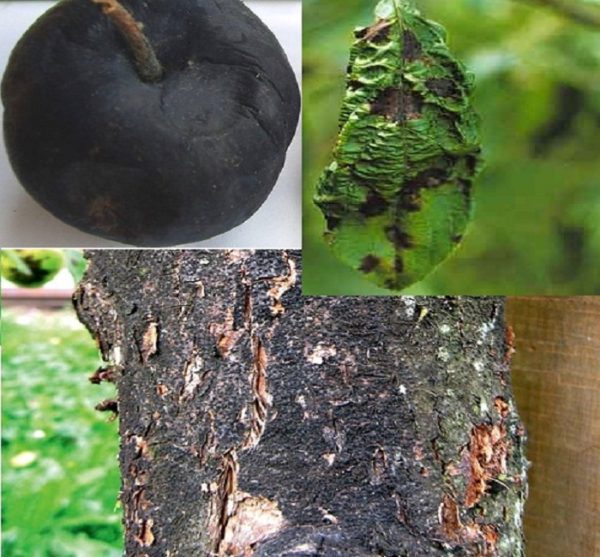

What does a black apple cancer look like, a photo of the affected parts: fruit, leaves, bark.
The reasons for the development of the disease
Apple tree cancer is a disease of the trunk and branches (rarely - flowers, leaves, fruits and roots). It is accompanied by the appearance of deep ulcers and darkening, decay of bark and wood. Cancer is caused by various types of fungi or bacteria. It develops with mechanical damage to the bark and the formation of wounds on the trunk. Cancer can be triggered by sudden changes in temperature, cool or rainy weather.
The spores of parasitic fungi often penetrate into the wounds, which is why the sores do not overgrow. Branches are covered with brown spots or black bloom. The tree bark dies off and falls off. Cancer tumors (sagging) or deep cracks appear at the site of the wounds. Infected branches dry up and break, after 2-3 years the fungus can destroy the entire tree.
Old apple trees are more likely to get cancer than young seedlings. Fungal spores penetrate into cracks in the bark, into wounds after pruning branches. The tree can become infected through frostbites and sunburn of the bark. Most often, weakened apple trees suffer from cancer, which lack nutrients for normal development. Insect pests can also bring fungal spores into the wounds.
Folk remedies
Folk remedies, how to treat apple cancer, suggest the replacement of natural chemicals.
So for disinfection of cleaned wounds they use:
- Brine with the addition of iodine,
- Soaked detergent powder,
- Laundry soap solution,
- Rubbing with fresh sorrel.
To isolate the wound from external influences are used:
A mixture of clay and mullein
A wet mixture is prepared (proportions 1: 1). A thick layer of the mixture is applied to the disinfected wood. At least 10 cm.
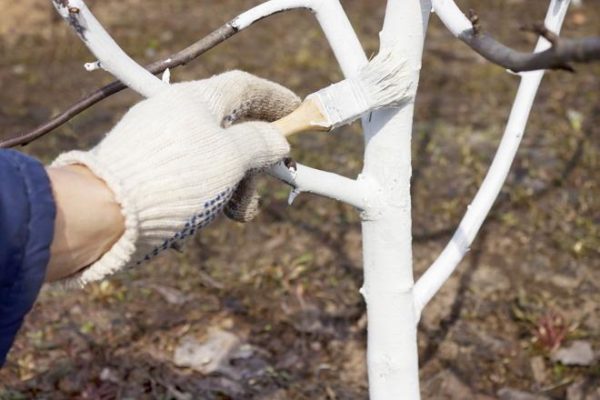

Whitewashing trees in spring with lime.
The place of damage is bandaged and again covered with mixture.
During the season, the place is wetted with water or heteroauxin (2 tablets per bucket of water), smeared with a fresh mixture.
A mixture of rosin, wax and nigrol
Impromptu putty is made up in a ratio of 1: 1: 1 and is applied to the damaged area of the bark.
When preparing clay, it must first be soaked and thoroughly kneaded after 2-4 hours.
The density of natural material changes.
Even one layer of such putty will adhere well, but more reliable apply 2-3 layers.
Each layer must be allowed to dry.
Garden land
Ordinary garden land also used by gardeners to treat black cancer.
The earth is moistened, applied to the wound, not bandaged. This method is quite laborious, since the land must first be treat with fungicide.
In the event of the onset of rains, the disinfection procedure and the application of soil will have to be repeated.
Apple tree bark
This is the way that advanced gardeners are proficient:
- Cut out piece of bark, contours exactly repeating the wound after surgery and disinfection.
- The edges are aligned
- Bandaged up,
- Processed with garden pitch.
Pathogen development cycle
Symptoms of black cancer can appear on different parts of the plant. In order to notice the symptoms in time and immediately begin treatment, you need to know them in advance.
What indicates that the trunk is affected by the disease:
- The appearance on the bark of round depressions of a brown shade.
- The formation of pycnidial tubercles in the depressions (they store spores of the fungus).
- The formation of a dark plaque on the affected areas.
- "Charring" of the affected area.
- Raising healthy bark at the borders of the affected area.
- The formation of a crack first between the diseased and healthy bark at the border of the affected area, and then along the entire trunk.
- The appearance of other cracks and blisters on the bark, resulting in the exfoliation of the bark so that the wood becomes visible.
- Blackening of bare wood.
Damage to the trunk is considered the most dangerous. If you do not start treatment in a timely manner, then in 3-4 years the apple tree will completely lose its bark and die.
Leaves
How to understand that the leaves of the apple tree began to hurt:
- Formation of small reddish spots on the entire surface of the leaves ("frog eyes").
- Growth of spots up to 5–6 mm.
- Brown stains.
- The appearance in the center of the spot of a gray area, which then begins to grow.
- The defeat of the entire leaf plate, as a result of which the leaf dries up and falls off.
As a rule, a diseased apple tree sheds its foliage early - about 2 months before the fruit ripens.
If there is damage on the apple (for example, from insects), then the manifestation of the disease will begin exactly in this place. The disease develops on an unripe apple.
Development of black cancer on fetuses:
- The appearance of dark subcutaneous spots on apples.
- Distribution of blackening over the entire surface.
- Blackening of the pulp.
- Shrinking and drying a completely black apple.
Additional treatments for black cancer
Based on antibacterial and antifungal properties of various drugs, gardeners use strong potassium permanganate solution.
It is used in cases where bark lesions are minor. To prepare the solution, take 2.5-5 grams of the substance per bucket of water.
The bucket doesn't have to be iron. Plastic or glass container volume of 10 liters.
The solution is used to treat the trunk and skeletal branches. In this case, it is not just necessary apply the solution to the apple tree, but try to saturate the wood with it, wash off the spores from the surface of the bark.
After completing the procedure, it is necessary to thoroughly spray the crown, trying not to miss a single branch, not a single leaf and fruit (in case the treatment takes place in the fall).
Nursery owners actively use manganese fertilizers in industrial gardening conditions.
Introduced into the soil 3-4 kg of manganese slow down the development of wounds of black apple crayfish and at the same time fertilize the soil.
Antibiotic treatment for apple cancer
Such treatment for bacterial and fungal infections of the bark of fruit trees is used in Europe instead of treatment with copper-containing drugs. In Russia, very few people use this method so far.
To try this method, you need streptomycin and tetracycline in powder, tablets or ampoules.
Spraying of diseased trees is carried out, after cleaning the wounds, starting with streptomycin.
A dose of 1 gram is 500,000 units, diluted in 5 liters of water. Apple trees are processed during the period of regrowth of young shoots - in June... Two to three treatments are carried out with an interval of 2-3 weeks.
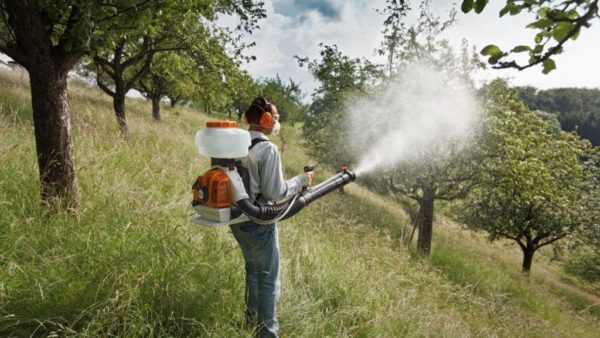

Garden processing.
Out of turn spray the gardenif it rains or is extremely hot.
There is another scheme in which the interval between treatments is 5 days, with a gradual increase in the dose.
So the first spraying is carried out in a standard dosage, in the second - 1 gram is diluted by four, and in the third - by three liters of water.
Next year streptomycin replace tetracycline (2 tablets for 5 liters of water).
Some experts believe that using antibiotics on plants is more environmentally friendly than using chemicals. They are less toxic and reproduce natural production processes antibiotics living organisms.
Stem injection
This method also involves using streptomycin in the treatment of black cancer. The works are carried out during growing season.
- At a level of about a meter from the ground, a hole is drilled in the apple tree with a depth of about 2 cm. There should be no cracks or other lesions of the bark near it, otherwise the solution will flow out of the body of the apple tree.
- A hose is tightly inserted into the hole through which the antibiotic solution will pass.
- A 4% streptomycin solution is fed through a special system under pressure.
- After completing the procedure the hole is closed with a plug.
- Each skeletal branch greater than 15 cm in diameter is considered a separate trunk.
- The holes in the branches are made at a height of 30-40 cm from the point of growth.
- The area of action of the drug is limited two meters up and one down along the processed trunk, relative to the injection hole.
- This treatment is repeated up to 5 times with an interval of a week.
This method does not involve either preliminary pruning or stripping of the apple tree. These works are carried out after processing the plant.
IMPORTANT! Antibiotic treatment is designed primarily for bacterial infectionsbut it can also help fight black cancer.
Fighting Bacterial Cancer of Fruit Trees
If the tree is severely damaged by bacterial cancer, it may be necessary to completely remove the entire plant.... If we observe, only, the initial manifestations of infection with this disease, it is worth making an attempt to cure the tree. The main procedures in the fight against bacterial cancer include pruning the affected branches, and then puttying the cutting site with garden ointment (var), with the addition of an antifungal agent (fungicide).
From trunks and thick branches that it is impossible to cut off completely, the dead bark is cut out to healthy tissue, after which these places are also smeared with ointment with a fungicide.
Also, do not forget to remove infected leaves and fruits from the garden. In particular, do not leave fallen leaves under the trees or send such leaves to compost (it is better to burn them). In spring, during the period of bud swelling and flowering, as well as in autumn, during the period of leaf fall, we spray using fungicides, for example, Median (Miedzian) 500 WP or Extra 350 SC, Bordeaux mixture (100 g of copper sulphate and 100 g of lime on 10 l of water), Hom preparation (80 g per 10 l of water).
We spray not only diseased trees, but all others for preventive purposes. Spraying should also be done as a preventive measure.if the disease was observed in previous years or in other surrounding gardens.
Spraying against bacterial cancer, carried out during the period of leaf fall, is especially important, because bacteria quite easily penetrate into the place from which the leaf fell. Therefore, if bacterial cancer has appeared in the surrounding gardens, it is worth even two sprays in the fall - the first, at the beginning of the period of falling leaves from the trees, and the second - at the end of the period of falling leaves.
"House garden vegetable garden"
If the article seemed interesting to you, please vote for it using your social network, and if you have something to add,
be sure to leave your comment on the site >>>
Preparations for the fight
Drugs for the treatment of black cancer can be roughly divided into three groups according to the principle of use:
- Means for treating wounds;
- Dispute elimination means;
- Fertilizers to improve the immunity of the tree.
Each group has its own uses.
So remedies for treating wounds are disinfecting and antifungal drugs, with which fungal infections are treated.
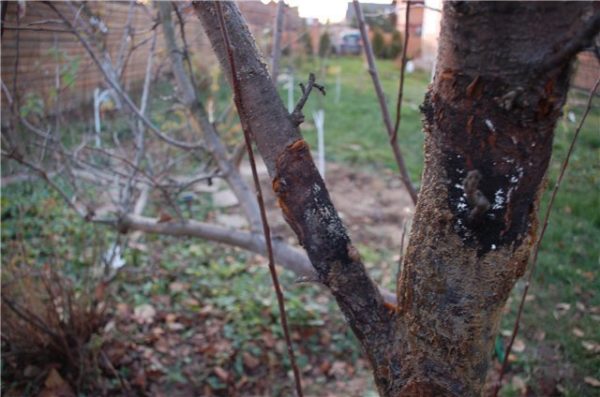

Apple black cancer disease, photo from gardeners.
An orchard is sprayed with agents for the destruction of spores.
Fertilizers to increase immunity apple trees can be watered near-stem circles and planting holes, as well as direct feeding, which achieve an effect faster, feeding the plants through leaves and shoots.
Copper preparations
Copper based products such as:
- Copper sulfate,
- Bordeaux mixture,
- HOM,
- Oxyhom,
- Abiga peak,
- Cuprostat,
- Tsikhom.
They are used to disinfect wounds. Since copper has a depressing effect on the development of the fungus, the same drugs can be used spraying vegetative mass apple trees.
In addition, copper is used for apple trees and as a top dressing. For their versatility, copper-based preparations are popular among gardeners.
Drugs with contact or systemic action, such as:
- Alirin-B,
- Gamair,
- Fitosporin,
- Strobe,
- Impact,
- Raek,
- Speed,
- Topaz,
- Strike,
- Kolfugo Super,
- Fundazol,
- Horus.
They are mainly used for spraying crowns and soil.
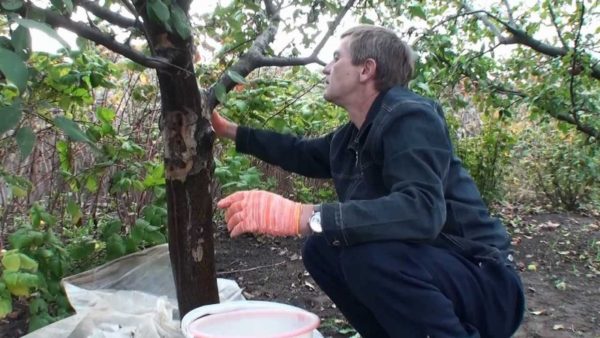

How apple cancer manifests itself and the fight against it - photo processing.
They inhibit not only black cancer, but also other fungal and bacterial infections.
Therefore, they can defeat a whole range of diseases that are caused by pathogens. Simultaneously with black cancer, fungicides can be treated:
- Cytosporosis,
- Common cancer
- Scab,
- Rust
- Powdery mildew etc.
Fungicides, intended to prevent the development of fungal infections, are allowed to be used in the summer during the ripening period of the fruit.
An important feature of fungicides for the treatment of black cancer is destruction of pestsweakening trees.
Protecting the tree from infections and pests, drugs of this group release the vitality of apple trees to fight a serious illness.
Important! Systemic drugs have another advantage. Spreading through the tissues of the apple tree, they are able destroy the fungus even in those places that the spraying has not touched.
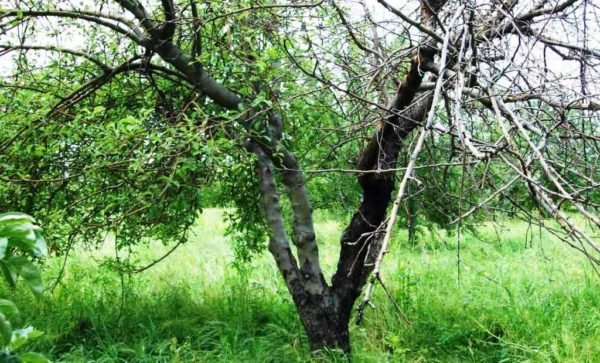

Apple tree disease black cancer: photo of a dying tree.
Contact and contact-systemic drugs are convenient to use for adding to those putties, which are applied to the affected areas of the bark.
The safest for wood in the composition of the putty work microbiological preparations bacteria-based:
- Gamair,
- Alirin,
- Fitosporin.
Their solutions can be successfully used to soak clay, mullein, earth.
A special place among these funds is occupied by Fitosporin.
One of the forms of release of the drug is paste. Therefore, Fitosporin, which has antimicrobial and antifungal properties, can independently act as a putty.
After removing the dead and diseased tissue, the wound is treated with an antiseptic, then it is laid Fitosporin.
The paste-like state of the drug allows it to be evenly applied to the wound. Fitosporin protects the affected area from external influences and at the same time has therapeutic effects.
Preparations have been developed to replace the diseased bark of fruit trees.
For example, artificial bark. It is worth treating such drugs critically and first try to use them on a small wound of a tree, which is not a pity.
Without letting the air in artificial materials can cause rotting wood underneath.
The natural moisture released by the living tissues of the apple tree can accumulate under the artificial bark, creating ideal conditions for the development of the fungus.
In industrial gardens in Europe, fungicides based on carbendazim and methyl thiophanate are actively used.
The most famous of them:
- Funaben and its derivatives, and
- Topsin M.
Funaben (Funaben Eco, Funaben 3) contact - systemic fungicide of Polish production, which neutralizes fungal diseases.
It is produced in canisters - 5 liters and bottles of 0.48 liters in the form of a concentrated solution.
A suspension prepared from the drug is processed open wounds before their protection from the external environment. Particular attention should be paid to exposed wood.
Funaben can only be used in dry weather. Excessive moisture will reduce the effect of the drug in the wound. Funaben is also produced spraying apple trees.
Complex preparation - protects against infections and pests.
Since Funaben introduces hormonal changes into tree tissues, it is practically not used on the territory of Russia.
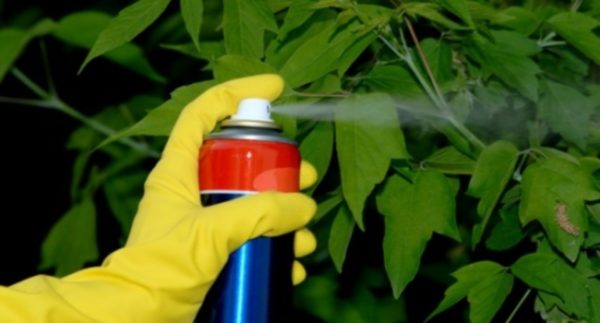

Fungicide treatment.
Topsin M - a drug of systemic action, used for spraying before and after flowering, and watering apple trees.
Actively works from the bottom up, through root system... Once at the infected site, Topsin M blocks the development of fungi and their spores during the first day.
It has a wound healing effect on the bark. There are several forms of release: soluble powder and concentrated emulsion.
Top dressing
A healthy tree, if there is no mechanical damage, has almost no chance of developing black cancer.
To maintain the tree, complex and one-component fertilizers are used:
- Ammonium nitrate,
- Superphosphate,
- Urea,
- Ammonium sulfate,
- Potassium nitrate,
- Potassium salt etc.
Organic preparations, which include live effective microorganisms (EM), are widely used. The most famous of these is Baikal EM 1.
Unlike chemical preparations, organic Baikal EM 1 needs preparation.
Microorganisms in the preparation are inactive.
For the beneficial bacteria to work, they must undergo a fermentation process. It takes about ten days.
To form a protective function, it is necessary to ferment at a temperature of 30-35 degrees:
- The drug is dissolved in boiled water at room temperature,
- added sugars. For each liter of solution, 1 tbsp is required. a spoonful of honey, molasses, jam or, in extreme cases, sugar.
- Cooked the solution should ferment in a dark place with the specified temperature and with occasional stirring.
Spraying the vegetative mass of apple trees with the preparation increases the immunity and resistance of trees to fungal infections.
Apple tree processing Baikal EM 1 stimulates the restoration of the cortex.
Advice. Watering and spraying the apple orchard with the drug in late autumn increases the resistance to cold, prevents the formation frostbite on the bark.
Antifungal treatment for humans
Some gardeners use human antimicrobial and antifungal drugs to treat apple trees, for example, Nystatin.
The expediency of this method is very doubtful... The nature of fungal diseases of plants and humans is different.
For example, Nystatin acts on Candida fungi that develop on the human mucosa.
A prerequisite for their development is a stable temperature of the human body. This type of fungus cannot grow and develop on trees.
This means that the drug will have nothing to fight against. For other types of fungus Nystatin It does not work.
It will not strengthen the defenses of the apple tree, controversy fungus will not destroy - will not have any positive impact.
It is not worthwhile to waste medicine, time and labor, when you can use proven, effective means.
Chemical and biological agents
Treatment of black cancer in apple trees involves the use of drugs aimed at destroying fungal spores and increasing the immunity of the tree.
Copper-containing products are suitable for disinfection, have a detrimental effect on the development of the pathogen and act as a fertilizer.
The vegetative part is sprayed:
- copper sulfate;
- Bordeaux mixture;
- complex substances: Hom, Kuprostat, Tsikhom, etc.
For spraying the soil and the crown, contact and systemic preparations with fungicides are used, which simultaneously affect the cancer pathogen, fungal and bacterial infections and pests:
- Topaz;
- Fundazol;
- Horus;
- Impact;
- Topsin-M;
- Funaben;
- Strobe and similar.
Fungicides keep the trees alive.
Compositions of biological effects, made on the basis of the vital activity of bacteria, are included in putties or in solutions for soaking clay, mullein and garden soil (Gamair, Alirin, Fitoporin).
Timing of Black Cancer Treatment
All surgical operations with apple trees it is necessary to carry out when the movement of juice in apple trees is slow.
Otherwise, the oozing moisture will not allow the wounds to heal for a long time and will create nutritious conditions for the development of the fungus.
During the year, there are two such periods:
- Early Spring, before the buds of the apple tree begin to grow;
- Late fallwhen the apple tree is ready for wintering and throws off the fruits and leaves.
This is the right time not only for operations on the bark, but also for pruning diseased branches.
IMPORTANT! If black cancer has struck more than one or two trees, but rages throughout the area, apple pruning not recommended.
Each cut is the place where the infection enters the body of the tree. Therefore, if the trees are not infected, during this period it is worth refraining from forming crowns and shortening branches.
Timing of spraying trees from black cancer depend on the development cycle of the apple tree. It is more correct and convenient to process an apple orchard early spring.
Since the treatment requires a thorough coating of the tree with a preparation, in the spring, when the foliage is still missing, it's easy to do.
More often, spraying is carried out before the buds awaken, at its beginning, before the apple tree blossoms and after flowering.
The next processing is usually done in the fall after harvest and before wintering.
When to carry out treatment procedures
All procedures for the treatment of black cancer on apple trees associated with cutting off damaged vegetative parts are planned for the period of slowing down of plant sap:
- in early spring before the start of active growth of the kidneys;
- in late autumn when preparing trees for wintering after they have thrown off foliage and apples.
Spraying with chemical and folk remedies is carried out depending on the vegetative cycle and the selected agent:
- chemical is used until the stage of awakening of the buds, before budding and before the formation of fruits;
- in the intervals between these treatments, they use folk remedies.
Prophylaxis
To prevent cancer from infecting a healthy apple orchard, it is necessary to prevent the occurrence of conditions that would facilitate infection.
- planting apple trees must be done in compliance intervalscorresponding to varieties and rootstocks;
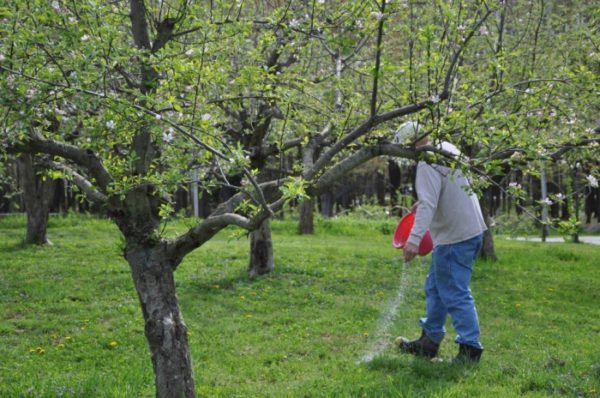

Correct planting of trees. - it is necessary to plan the planting so that the overgrown crowns of trees did not touch and well ventilated;
- when buying planting material, it is necessary to carefully examine not only the ground part of the apple trees, but also root system, otherwise black crayfish can be bought with a seedling;
- apple trees need to be provided with good care, which involves the correct use of fertilizing, pest protection, cleanliness of the territory; protection from sunburn and frost damage in winter and spring.
- pruning apple trees must be done correctly, leaving no stumps, after each cut, decontaminate the instrument, protect the cut.
In warm climates, such as the South of Russia, Tatarstan, Belarus, Ukraine, where the temperature difference with the change of seasons is quite mild, black cancer affects only old apple trees... Therefore, the contamination of the garden depends only on poor agricultural technology.
In Moscow, the Moscow region, the middle lane and in the north-west of Russia, in Siberia and the Urals the disease threatens apple trees of any age, since they have more risks of getting mechanical injuries.
Therefore, an important signal that the variety can resist black crayfish is winter hardiness.
IMPORTANT! In any region, only local varieties should be planted. Their immunity is higher than that of plants brought from other climatic zones.
Resistance of varieties to black crayfish:
It is important to prevent the appearance of black cancer in the garden. selection of resistant varieties.
There are no varieties that are completely resistant to black crayfish, but there are varieties that are least likely to be affected.
Severely affected by black cancers varieties:
- Anis scarlet, Anise pink, Antonovka, Wanda, Verbnoe, Wilhelm, Memory of Kovalenko, Raika, Renet gold, Renet Simirenko Sava, Slava Primorya, Champion.
Moderately affected by black cancer:
- Antey, Banana, Spartan, Orlik, Rubin, Alesya, Pinova, Pikant, Jonafrey, Redfrey.
Summer varieties of apple trees resistant to black crayfish:
- Alva, Malt Bagaevsky, Papirovka.
Autumn varieties that are relatively resistant to black crayfish:
- Borovinka, Cinnamon striped, Autumn joy, Freedom.
Winter varieties relatively resistant to black crayfish:
- Bolotovskoe, Jonathan, Iedzenu, Lobo, Zarya Alatau, Pashkevich's Memory, Steadfast, Kharalson.
Preventive measures
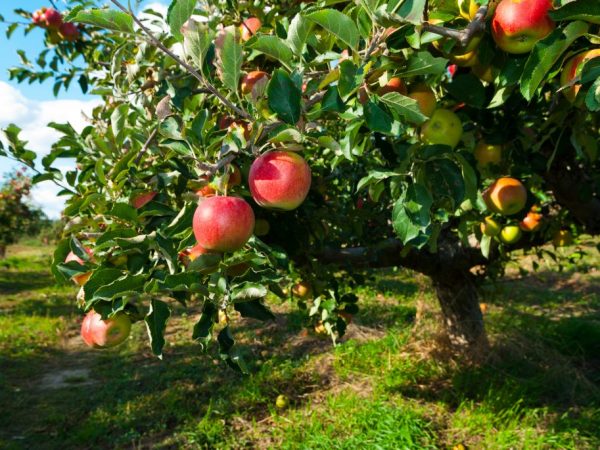

Proper care will help avoid infection
Preventive measures are related to the basic rules of agricultural technology when growing horticultural crops:
- the planting of trees is planned taking into account the recommended distance between them of 3 m or more, avoiding the proximity of compost pits with organic matter to them, while for planting, preference is given to places closed from constant exposure to sunlight, because constant exposure to ultraviolet radiation often leads to burning of the foliage, which becomes a favorable factor for the development of the fungus;
- for proper air circulation, the apple crown is regularly cut off, keeping an angle of more than 45 °;
- uprooting old, obsolete apple trees, or, if they intend to preserve them, carry out a thorough cleaning of the tree bark, which improves gas exchange and destroys possible fungal spores and pests that have accumulated under the dead tissues;
- whitewashing is carried out at a height of up to 2 m, incl. in the spring to the blossoming buds and in the fall after the fall of the foliage;
- in regions with an unfavorable environment for black crayfish due to climatic conditions conducive to the appearance of infection, varieties resistant to fungus are planted.
Black crayfish resistant varieties
Gardeners in regions with warm and humid climates, when choosing varietal varieties of apple trees, opt for cancer-resistant ones:
- show average resistance Spartan, Orlik, Pinova, Redfrey and others;
- summer - Papirovka, Alva, Baagaevsky and others;
- autumn - Borovinka, Freedom, Korichno and others;
- winter varieties - Jonotan, Stoykoe, Lobo, Zarya Alatau, etc.
Symptoms of a bacterial infection
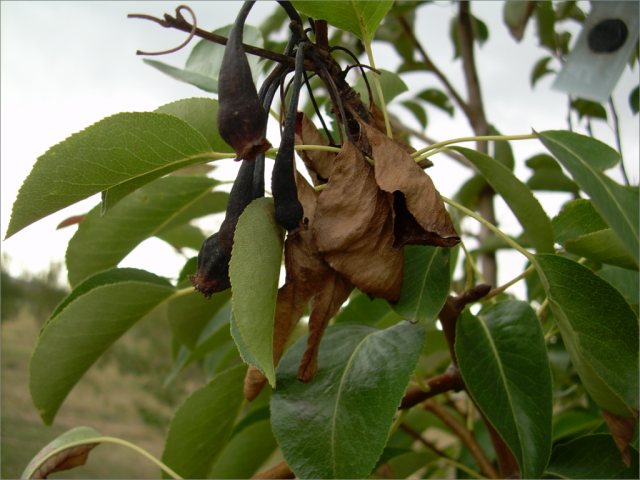

Bacterial burn of an apple tree. <>
Typical symptoms of bacterial damage to the aboveground organs of apple trees:
at bacterial cancer or bacterial necrosis are the appearance of blisters on young shoots, which break open, exposing the internal tissues of the plant. The leaves are covered with brown spots. In general, the affected plant organs have dents of pink-brown colors with a purple border,
at fire blight the affected tree branches look scorched by fire. The manifestation of the disease begins in early spring (budding) in the form of browning and blackening of the generative and vegetative organs, the cessation of their growth and development. The tree may suddenly die or become covered with bubbles of various sizes filled with bacterial mucus. It flows from wounds, ovaries, cracks in the bark, bursting bubbles. Covers the affected organs with a gray film or solidifies in the form of milky white drops. The multiplied bacteria move from young to larger plant organs through the vessels, causing the death of the entire plant,
at bacterial root cancer the disease can manifest itself first on the root collar and then on the trunk and branches of trees in the form of smooth growths, which ulcerate over time and acquire a brown or black color. Bacteria, penetrating into tissues through wounds, cracks, cuts (cuts), damage to the integrity of the bark by insects, develop rapidly.They cause increased division of tissue cells and, as a result, the growth and formation of slugs. The influxes decay over time, bacteria move into the healthy tissue of the aboveground and underground organs, including the roots. Growing on the roots, the tumor becomes hard. The aboveground and underground organs cannot function normally and the tree dies.
Diseases of the trunk of apple trees: their signs and treatment (with photo)
The most common apple tree trunk disease is root rot, with only scab rivals in prevalence. We offer you to find out all the necessary information about apple tree trunk diseases and their treatment so that this defeat is not taken by surprise.
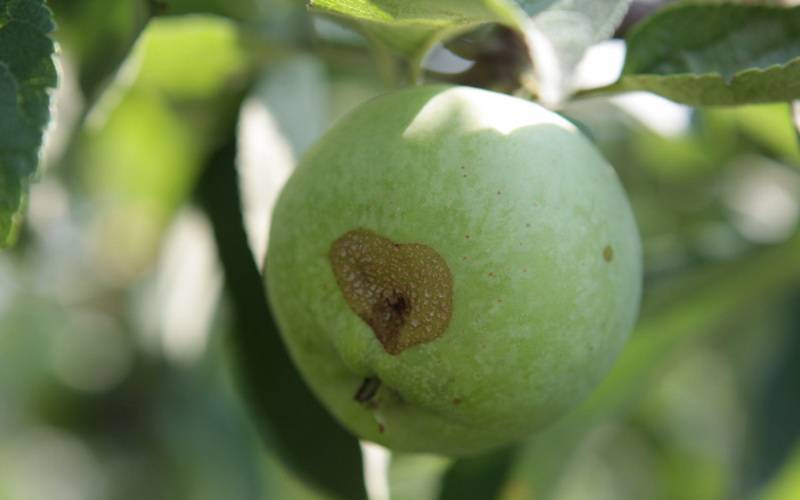

The causative agent is the mushroom Armillaria mellea (Vahl.) P. Kumm. (syn.Armillariella mellea (Vahl.) P. Karst.), causes peripheral wood rot. Honey mushroom grows on the roots of living trees and shrubs, as well as on stumps.
Under the affected bark of roots, butts, base of trunks and shoots, the fungus forms a network of black flat cords - rhizomorphs, with the help of which it actively spreads. On the mycelium, numerous fruiting bodies are formed in the form of yellow-brown caps with a stem and a filmy ring under the cap.
The fungus persists in the wood, in the soil in the affected plant debris, penetrates the root system of trees and shrubs, causes the wood roots and trunks to die off, which is why the lesion is called peripheral rot.
Control measures. Preventive spraying of trunks and branches with 1% Bordeaux mixture or its substitutes (HOM, Abiga-Peak). Removal and burning of affected dead trees along with roots. At the first signs of infection, the soil under the trees is spilled with a solution of a copper-containing preparation.
The causative agent is the mushroom Venturia inaegualis Wint. with conidial stage Fusicladium dendriticura (Wallr.) Fuck. Dark green, gradually turning brown velvety spots appear on the leaves on the upper side, the leaves turn yellow and fall off prematurely.
When infected in spring and early summer, the spots are large, later, with repeated re-infestations, they are small, hardly noticeable. Spores re-infect the ovaries, less often young shoots, the fruits become stained and become unusable.
With the massive spread of scab, the commercial qualities of the fruits, the decorativeness and winter hardiness of trees decrease. The development of the disease is favored by a wet, cold spring and an abundance of precipitation in summer. The causative agent is distinguished by a narrow specialization, that is, the fungus infects only the apple tree and does not spread to other trees. The infection persists in the affected plant debris.
Control measures. Collection and removal (possibly composting) of fallen diseased leaves. Spraying trees, starting from the green cone phase and, if necessary, in the summer, taking into account the waiting time, with one of the preparations: 1% Bordeaux mixture, HOM, Abiga-Peak, fast, rayok. It is easier to navigate in phases: before flowering and immediately after flowering.

